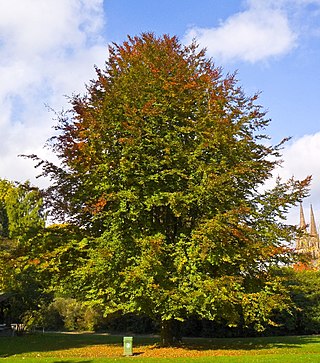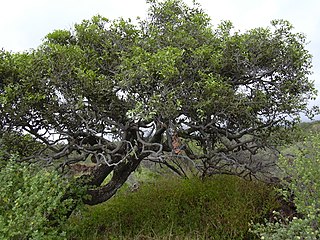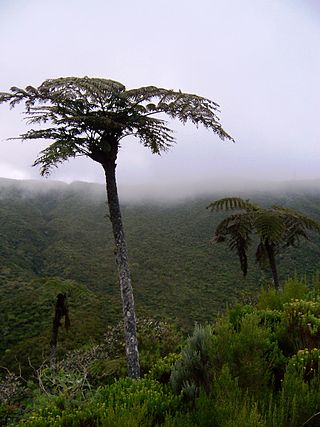
The Cucurbitales are an order of flowering plants, included in the rosid group of dicotyledons. This order mostly belongs to tropical areas, with limited presence in subtropical and temperate regions. The order includes shrubs and trees, together with many herbs and climbers. One major characteristic of the Cucurbitales is the presence of unisexual flowers, mostly pentacyclic, with thick pointed petals. The pollination is usually performed by insects, but wind pollination is also present.

The Mimosoideae are a traditional subfamily of trees, herbs, lianas, and shrubs in the pea family (Fabaceae) that mostly grow in tropical and subtropical climates. They are typically characterized by having radially symmetric flowers, with petals that are twice divided (valvate) in bud and with numerous showy, prominent stamens.

The Fagaceae are a family of flowering plants that includes beeches, chestnuts and oaks, and comprises eight genera with about 927 species. Fagaceae in temperate regions are mostly deciduous, whereas in the tropics, many species occur as evergreen trees and shrubs. They are characterized by alternate simple leaves with pinnate venation, unisexual flowers in the form of catkins, and fruit in the form of cup-like (cupule) nuts. Their leaves are often lobed, and both petioles and stipules are generally present. Their fruits lack endosperm and lie in a scaly or spiny husk that may or may not enclose the entire nut, which may consist of one to seven seeds. In the oaks, genus Quercus, the fruit is a non-valved nut called an acorn. The husk of the acorn in most oaks only forms a cup in which the nut sits. Other members of the family have fully enclosed nuts. Fagaceae is one of the most ecologically important woody plant families in the Northern Hemisphere, as oaks form the backbone of temperate forest in North America, Europe, and Asia, and are one of the most significant sources of wildlife food.

Oleaceae, also known as the olive family or sometimes the lilac family, is a taxonomic family of flowering shrubs, trees, and a few lianas in the order Lamiales. It presently comprises 28 genera, one of which is recently extinct. The extant genera include Cartrema, which was resurrected in 2012. The number of species in the Oleaceae is variously estimated in a wide range around 700. The flowers are often numerous and highly odoriferous. The family has a subcosmopolitan distribution, ranging from the subarctic to the southernmost parts of Africa, Australia, and South America. Notable members include olive, ash, jasmine, and several popular ornamental plants including privet, forsythia, fringetrees, and lilac.

Armillaria is a genus of fungi that includes the A. mellea species known as honey fungi that live on trees and woody shrubs. It includes about 10 species formerly categorized summarily as A. mellea. Armillarias are long-lived and form the largest living fungi in the world. The largest known organism covers more than 3.4 square miles (8.8 km2) in Oregon's Malheur National Forest and is estimated to be 2,500 years old. Some species of Armillaria display bioluminescence, resulting in foxfire.

The Araliaceae are a family of flowering plants composed of about 43 genera and around 1500 species consisting of primarily woody plants and some herbaceous plants commonly called the ginseng family. The morphology of Araliaceae varies widely, but it is predominantly distinguishable based on its woody habit, tropical distribution, and the presence of simple umbels.

The Ebenaceae are a family of flowering plants belonging to order Ericales. The family includes ebony and persimmon among about 768 species of trees and shrubs. It is distributed across the tropical and warmer temperate regions of the world. It is most diverse in the rainforests of Malesia, India, Thailand, tropical Africa and tropical America.

The Buxales are a small order of eudicot flowering plants, recognized by the APG IV system of 2016. The order includes the family Buxaceae; the families Didymelaceae and Haptanthaceae may also be recognized or may be included in the Buxaceae. Many members of the order are evergreen shrubs or trees, although some are herbaceous perennials. They have separate "male" (staminate) and "female" (carpellate) flowers, mostly on the same plant. Some species are of economic importance either for the wood they produce or as ornamental plants.

Dipterocarpaceae is a family of flowering plants with 22 genera and about 695 known species of mainly lowland tropical forest trees. Their distribution is pantropical, from northern South America to Africa, the Seychelles, India, Indochina, Indonesia, Malaysia and Philippines. The greatest diversity of Dipterocarpaceae occurs in Borneo.

Aextoxicon is a genus of dioecious trees native to southern Chile and Argentina. It is the only genus in the monotypic family Aextoxicaceae, and is itself represented by the olivillo. It is a large evergreen tree native to the forests of the Valdivian temperate rain forests and Magellanic subpolar forests of the Pacific coast of southern Chile, where it forms is a canopy tree in the broadleaf forests. It can reach 15 m tall.

The Crypteroniaceae are a family of flowering trees and shrubs. The family includes 13 species in three genera, native to Indomalaya.

The Cyatheaceae are a family of ferns, the scaly tree ferns, one of eight families in the order Cyatheales in the Pteridophyte Phylogeny Group classification of 2016. Alternatively, the family may defined much more broadly as the only family in the Cyatheales, with the PPG I family treated as the subfamily Cyatheoideae. The narrower circumscription is used in this article.

Gomortega keule is a species of tree endemic to Chile. It is the sole species of the genus Gomortega and, according to the APG IV system of 2016, of the monotypic family Gomortegaceae, assigned to the order Laurales in the clade magnoliids.

Koompassia is a genus of legume in the family Fabaceae. It includes three species with range across southeast Asia, from Thailand to New Guinea. It belongs to the subfamily Dialioideae. They are tall tropical forest trees; K. excelsa is one of the tallest tree species in the tropics.

Plagiogyria is a genus of ferns, the only genus in family Plagiogyriaceae in the Pteridophyte Phylogeny Group classification of 2016. Alternatively, the family may be treated as the subfamily Plagiogyrioideae of a very broadly defined family Cyatheaceae, the placement used for the genus in Plants of the World Online as of November 2019.

Iteaceae is a flowering plant family of trees and shrubs native to the eastern USA, southeastern Africa, and south and Southeastern Asia. Some older taxonomic systems place the genus Itea in the family Grossulariaceae. The APG III system of 2009 includes the former Pterostemonaceae in Iteaceae. Consequently, it now has two genera with a total of 18 known species.

Recordoxylon is a genus of flowering plants in the legume family, Fabaceae. It includes three species of trees native to the tropical Amazon rainforest of northern South America, and the species' range includes northern Brazil, Colombia, French Guiana, Guyana, and Venezuela. Habitats include non-flooded rain forest on terra firme, seasonally-flooded riverine forest (várzea), and montane forest.

Martiodendron is a genus of flowering plants in the family Fabaceae. It includes five species of trees native to northern South America, from southern Venezuela, the Guianas, and Peru to Bolivia and southeastern Brazil. Typical habitats include tropical rain forest, often periodically inundated, in both the Amazon and Atlantic forests, as well as seasonally-dry forest and wooded grassland (savanna), up to 600 meters elevation. The genus belongs to the subfamily Dialioideae.

Eucalyptus tetrapleura, commonly known as the square-fruited ironbark, is a species of small to medium-sized tree that is endemic to northern New South Wales. It has thick, dark ironbark on the trunk and branches, lance-shaped to curved adult leaves, flower buds in groups of seven, white flowers and conical fruit that is square in cross-section.
Aporosa tetrapleura is a species of plant in the family Phyllanthaceae found in Cambodia and Vietnam. The wood is used in house and cattle barn construction and as firewood.


















